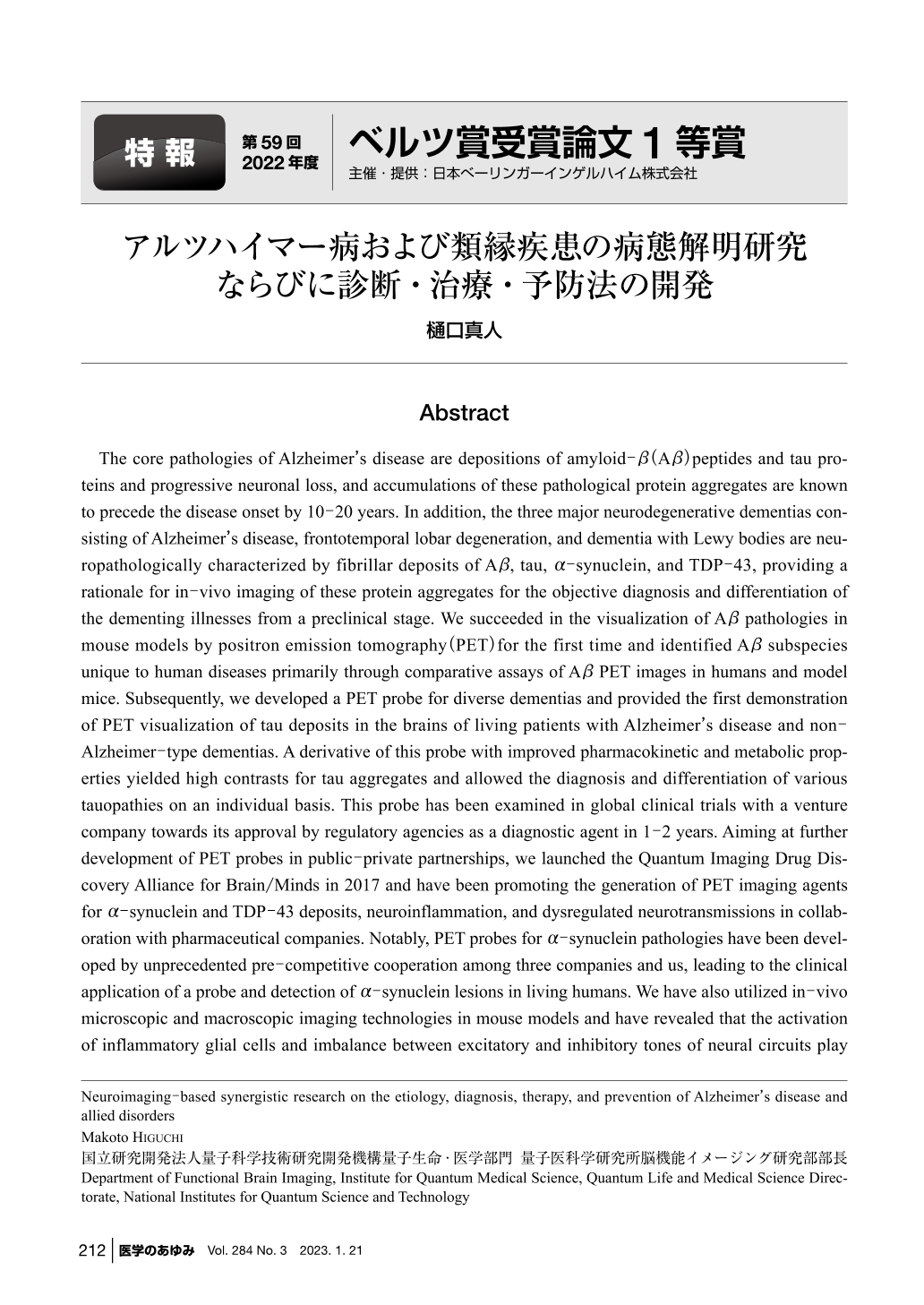Japanese
English
- 有料閲覧
- Abstract 文献概要
- 1ページ目 Look Inside
- 参考文献 Reference
抄録
アルツハイマー病(AD)の中核病態は,アミロイドβペプチド(Aβ)とタウタンパク質の脳内沈着と,進行性の神経細胞死である.Aβやタウの沈着は発症より10~20年先立って生じることが知られている.また,AD,前頭側頭葉変性症,レビー小体型認知症(DLB)からなるいわゆる三大認知症では,Aβ,タウ,αシヌクレイン,TDP-43の4種類のタンパク質が病的な凝集体を形成して脳に沈着することから,これらの凝集体病変の生体画像化によって,認知症の超早期診断や客観的な鑑別が実現すると目される.我々は認知症病態モデルマウスのAβ病変をポジトロン断層撮影(PET)により可視化することに世界に先がけて成功し,モデルマウスとヒトの画像所見の違いを起点として,ヒト疾患に特有のAβ亜種を同定した.次いで各種認知症のタウ病変を画像化するPETプローブを開発し,ADと非アルツハイマー型認知症患者脳におけるタウ沈着をはじめて実現した.このプローブを改良した高コントラスト診断薬により,多様な認知症の診断と鑑別が個々人のレベルで可能になり,ベンチャー企業との連携で1~2年後の実用化に向けたグローバル臨床試験を実施している.さらなるPETプローブの開発を産学連携で促進するために,我々は2017年に「量子イメージング創薬アライアンス・脳とこころ」を設立し,αシヌクレイン・TDP-43病変や神経炎症,神経伝達異常のPETプローブ開発を製薬企業との共同で進めている.特にαシヌクレイン病変PETプローブ開発は,世界で類を見ない複数企業との同時連携により臨床応用を達成し,ヒトで有望な結果が得られ始めている.さらにモデルマウスのミクロとマクロの画像評価系を活用することで,炎症性グリア細胞の活性化や神経回路の興奮-抑制バランスの失調が病態全体に重大な影響を及ぼし,これらを抑制する治療・予防薬候補物質によって疾患修飾療法が実現しうることを明らかにした.候補物質の一部はすでに臨床評価を実施中である.PET検査は病態の詳細な情報をもたらすが,高齢者の認知症マススクリーニングには血液検査が必要となる.そこで学学連携の多施設ネットワークであるMulticenter Alliance for Brain Biomarkersを2020年に立ち上げ,国内17施設との共同によって画像と血液のバイオマーカーを,相互参照して共進化の形で開発する体制を実現した.このようにモデル動物とヒトをイメージングでつなぐことを特色とする我々の研究開発においては,ADや類縁疾患の病態解明と診断・治療・予防法創出のブレークスルーとなる数多くの成果と知見が得られている.
Abstract
The core pathologies of Alzheimer’s disease are depositions of amyloid-β(Aβ)peptides and tau proteins and progressive neuronal loss, and accumulations of these pathological protein aggregates are known to precede the disease onset by 10-20 years. In addition, the three major neurodegenerative dementias consisting of Alzheimer’s disease, frontotemporal lobar degeneration, and dementia with Lewy bodies are neuropathologically characterized by fibrillar deposits of Aβ, tau, α-synuclein, and TDP-43, providing a rationale for in-vivo imaging of these protein aggregates for the objective diagnosis and differentiation of the dementing illnesses from a preclinical stage. We succeeded in the visualization of Aβ pathologies in mouse models by positron emission tomography(PET)for the first time and identified Aβ subspecies unique to human diseases primarily through comparative assays of Aβ PET images in humans and model mice. Subsequently, we developed a PET probe for diverse dementias and provided the first demonstration of PET visualization of tau deposits in the brains of living patients with Alzheimer’s disease and non-Alzheimer-type dementias. A derivative of this probe with improved pharmacokinetic and metabolic properties yielded high contrasts for tau aggregates and allowed the diagnosis and differentiation of various tauopathies on an individual basis. This probe has been examined in global clinical trials with a venture company towards its approval by regulatory agencies as a diagnostic agent in 1-2 years. Aiming at further development of PET probes in public-private partnerships, we launched the Quantum Imaging Drug Discovery Alliance for Brain/Minds in 2017 and have been promoting the generation of PET imaging agents for α-synuclein and TDP-43 deposits, neuroinflammation, and dysregulated neurotransmissions in collaboration with pharmaceutical companies. Notably, PET probes for α-synuclein pathologies have been developed by unprecedented pre-competitive cooperation among three companies and us, leading to the clinical application of a probe and detection of α-synuclein lesions in living humans. We have also utilized in-vivo microscopic and macroscopic imaging technologies in mouse models and have revealed that the activation of inflammatory glial cells and imbalance between excitatory and inhibitory tones of neural circuits play crucial roles in the etiological processes of neurodegenerative dementias. Hence, candidate new drugs and food ingredients capable of suppressing these key pathological events have been proven to offer disease-modifying treatments, and several of these candidates are being tested in clinical studies and trials. PET scans give in-depth pathophysiological information, while blood-based biomarkers will be essential for the mass screening of the elderly population for dementias. We established the Multicenter Alliance for Brain Biomarkers(MABB)in 2020 as an academic network for the co-evolution of imaging- and blood-based biomarkers with reference to each other, and the consolidation of biological data and samples from 17 MABB sites has been realized. Thus, our dementia research and development programs translationally linking animal models and humans by imaging techniques have produced breakthroughs in the elucidation of disease mechanisms and discoveries of diagnostic, therapeutic, and preventive agents.

Copyright © 2023 Ishiyaku Pub,Inc. All Rights Reserved.


